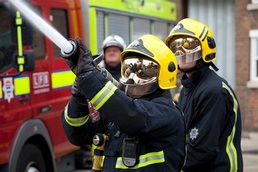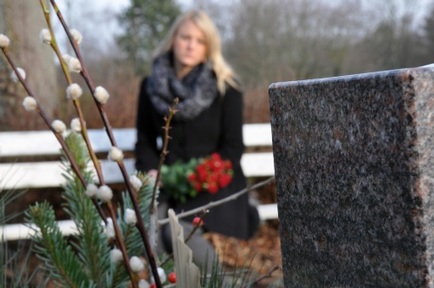Fire safety experts call for immediate action to 'prevent more loss of life' in care homes
Independent fire safety experts Safety Management UK are the latest to put pressure on government ministers to make fire sprinklers law in care homes, having written to Communities Secretary Eric Pickles.
The ’s (BAFSA) campaign has seen growing momentum in the last few years, voicing a powerful argument for modern sprinkler systems that have no known safety issues and are found to control 99 per cent of fires in sprinkler-controlled buildings.
The tragic deaths of fourteen residents at Rosepark care home, in South Lanarkshire, in 2004, provided a powerful argument for the installation of sprinklers, especially after the results of 141 days of evidence were published in 2011, as do the conclusions of the recently published verdict into the 2009 Lanakal House fire, in Southwark, where six people lost their lives.

Managing director of Safety Management UK, Brian Gregory, comments: “What the Lakanal House inquest has highlighted are major failings in the way fire safety is being addressed across the UK today.
“We not only need to learn the lessons of this terrible tragedy, we need to act on the findings of the coroner immediately to prevent more loss of life.
“We believe sprinklers do and will save lives. The evidence is there, there has not been a single fatality in any building in the world that has installed a working system.
“They can be retro-fitted at a reasonable cost, they should be installed in every new care home and social housing complex constructed in the UK and it should be a matter of law.
“Our advice to all landlords is simple. Fit sprinklers, and fit them now.”
Mr Gregory added: “We are calling on politicians and fire safety leaders to join with us in making sure this happens and that it happens quickly.”
There are signs that the political battle to make sprinklers compulsory in care homes is beginning to be won; the Welsh Assembly has announced that as of September 2013 all new care homes will be required to have sprinklers fitted, while such legislation already exists in Scotland.
The US government is also poised to make sprinklers law, but as yet there has been no significant moves from within Westminster, even though London Fire Brigade (LFB) figures show there to be more than ten care home fires in London in one week alone.
LFB deputy commissioner Rita Dexter is in full support of the sprinkler campaign, saying: “Older people, as well as people with mental health problems and those with mobility issues, are the group most at risk from fire and we are concerned by the number of vulnerable people like this who are still harmed or killed by fire in places where they should be safe.

“That’s why we want to see all residential care homes fitted with sprinklers. The number and regularity of care home fires that the Brigade attends is clear evidence that builders, developers, local authorities and private providers need to stop ignoring their benefits.”
The Stoke-on-Trent and Staffordshire Fire and Rescue Authority is another fire service keen to highlight the issue, praising the actions of local care home Goldendale House in deciding to install a sprinkler system last year.
Chairman and councillor Len Bloomer commented: “We applaud the care home for taking the care of their residents so seriously, we certainly hope other care homes follow their lead. Care homes in Scotland and Wales are now required to fit sprinklers, why should the people of England expect anything less?
“We’re campaigning both locally and nationally for the increased use of sprinklers and we’d urge local residents to do their bit by pushing this issue with their local councillors and MPs.”
Goldendale House care home director Lee Stringfellow commented: “The safety of our residents is of paramount importance to us and obviously our residents are more vulnerable than most. We wanted to ensure the building was to the highest fire safety standards and so the fitting of sprinklers has allowed us to achieve this. If there were ever to be a fire the disruption would be kept to a minimum which is certainly reassuring to our residents and their families.”
Of course fire prevention, where possible, is always a preferable solution, as targeted by the City of Edinburgh Council in the opening of six ‘swap shops’ recently for people to upgrade their power socket adaptors. In collaboration with Trading Standards, the council was triggered into taking action by statistics that show a staggering 92 per cent of power adaptors to have safety issues – the ‘swap shops’ made safer ‘bar’ socket extensions available to reduce unnecessary weight tensions.
Lorraine Carney, senior campaigns manager at the Electrical Safety Council, welcomed the initiative, saying: “According to government statistics, almost half of all accidental fires in UK homes – that’s over 20,000 each year – are caused by electricity, so we are delighted to work with the City of Edinburgh Council to support their innovative scheme, and make people aware of where electrical dangers may arise in their homes and how to prevent them.”
Councillor and community safety leader, Cammy Day, said: “To take part in the scheme, you can simply turn up with an old power socket adapter and hand it over in return for a free bar socket extension. We hope those most in need will come and take advantage of this opportunity to make their home that bit safer.”

At the same time as wanting to see fire sprinklers made compulsory, Safety Management UK wants to see more pressure on landlords and local authorities to identify breaches of safety legislation, particularly in respect of ‘compartmentation’, (the technique used in construction to contain fire outbreak as much as possible). While also advising all care home owners to review their management procedures and advice to tenants, and to undertake fire safety audits to assess whether ‘stay put’ evacuation procedures are needed.
In the case of the Lanakal House tower block, Brian Gregory says that, “The inquest was told that this fire spread rapidly, both upward and downward, because renovations made to the high-rise had decreased its compartmentalisation capability.
“This is a worrying issue that we have been raising for some time now and we have evidence from many of our own risk assessment work, carried out with expert teams, that compartmentation is being compromised, or in some cases doesn’t exist at all.
“The advice to stay put in the event of a fire makes sense and works because of compartmentation. That is why it is vital this issue is addressed in every apartment block in the country.
“We’d like to see changes that would allow fire risk assessors to go into people’s flats and look to see if work has been carried out that has compromised compartmentation.”
Head of compliance, Roger Balderstone, adds: “Local authorities and landlords need to make sure those people who are ordering work on buildings are aware of what is needed to ensure materials used have the right fire protection qualities.
“Again, we’d like to see a lead from central government in making this awareness and the training needed statutory.”
Latest Features News
 25-Nov-19
2019 Election: Boris Johnson leaves social care in 'too difficult box' but Labour vows to end 'crisis'
25-Nov-19
2019 Election: Boris Johnson leaves social care in 'too difficult box' but Labour vows to end 'crisis'
 18-Oct-19
Podcast: Wendy Mitchell and dementia: 'My biggest fear is not knowing who my daughters are'
18-Oct-19
Podcast: Wendy Mitchell and dementia: 'My biggest fear is not knowing who my daughters are'
 27-Sep-19
Exclusive: Care minister backs care workers' call for time off to grieve and attend funerals
27-Sep-19
Exclusive: Care minister backs care workers' call for time off to grieve and attend funerals
 19-Sep-19
Podcast: Gyles Brandreth says poetry helps ward off dementia
19-Sep-19
Podcast: Gyles Brandreth says poetry helps ward off dementia
 30-Aug-19
Edinburgh Fringe funnyman joins comics facing toughest audience at care home gig
30-Aug-19
Edinburgh Fringe funnyman joins comics facing toughest audience at care home gig